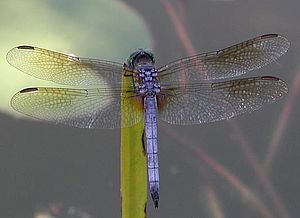Nature Note: Dragonflies and Damselflies

Photo from Wikipedia.org
Their names can evoke spine-chilling fear - bog haunter, pond hawk, shadow dragon, widow skimmer - or elfin magic - jewel wing, aurora dancer, sedge sprite. They are the subject of old wives tales about sewn lips of misbehaved children or their ability to reincarnate snakes. Few animal groups inspire more colorful stories than dragonflies and damselflies. Yet, even if the wives tales are not true and the names are only fanciful, these insect masters of the sky still lead fascinating lives. Together, dragonflies and damselflies comprise the insect order Odonata or “toothed ones”. Generally, dragonflies are faster and larger than damselflies, but the most reliable visual difference between the two groups is how they hold their wings when resting. Dragonflies hold their wings horizontal to the ground while most damselflies hold theirs perpendicular. Both groups are predators as adults and nymphs.
Odonates spend most of their life under water as nymphs. Nymphs can be found in many parts of Lake Champlain and other water bodies, but they generally prefer weedy sections. The weeds support an abundance of food and places to hide from fish that would otherwise eat them. Dragonfly nymphs have inspired horror stories, reportedly including the creature in the Alien movies. They have a hinged mask attached to their lower lip which can be extended about half the length of their body. As the mask shoots forward, spines on the end spread out to impale passing prey which can then be dragged reluctantly to the nymphs waiting jaws. The nymphs are voracious and large ones can take newts, tadpoles, or even small fish.
Only after a period, which can last between three months for some species and ten years for others, they emerge as the adults with which we are most familiar. Each adult may only live a few days during which time its principal activities are feeding and mating. Adults are among the most acrobatic flyers in the animal kingdom. They can maneuver forward and backward, or hover like a helicopter. Some species can reach speeds in excess of 30 miles per hour.
Many nature watchers have observed the aerial acrobatics of odonate reproduction. First, the male will fly by the female and grasp her head with specialized appendages on his abdomen. The couple is then said to be in “tandem”, and they may fly like this. The female then curls her abdomen toward a specialized pocket closer to the male’s thorax where sperm is stored. At this point the couple is said to be in the “wheel” position, which may occur in flight or while resting. One thought is that the complicated grasping and flying routine helps the male avoid being eaten by the female after his donation to the offspring is complete. After the female accepts the sperm, the male may guard his mate to assure that the eggs she lays were fathered by him. Guarding may mean maintaining the tandem position or he may simply hover nearby and chase off rivals. Depending on the species, the female lays eggs in slits she makes in plants or simply deposits the eggs into the water.
